Critical Evaluation of Tax-Related Risks in Digitalized Business
VerifiedAdded on 2022/05/11
|9
|2099
|29
Report
AI Summary
This report critically examines the tax-related risks that businesses encounter in the increasingly digitalized world. It begins with an introduction highlighting the complexities of taxation in the digital age. The report then identifies and evaluates potential tax risks, including complexities in tax compliance, internal disruptions, financial risks, and changes to reputational risk. It further delves into the prevention and management of these risks, suggesting strategic frameworks, collaboration with governments, and engagement with tax experts. Additionally, it discusses the importance of a conceptual framework for tax issues, along with the adoption of tax planning strategies like strategic incorporation, accelerated depreciation, and employee stock options. The report concludes by emphasizing the need for businesses to be prepared to supply accurate and qualified data on time, and to consider their readiness for the digital tax administration. The report utilizes multiple sources to support its analysis, offering valuable insights into the impact of digitalization on tax administration and business operations.

TAXATION
1 | P a g e
1 | P a g e
Paraphrase This Document
Need a fresh take? Get an instant paraphrase of this document with our AI Paraphraser
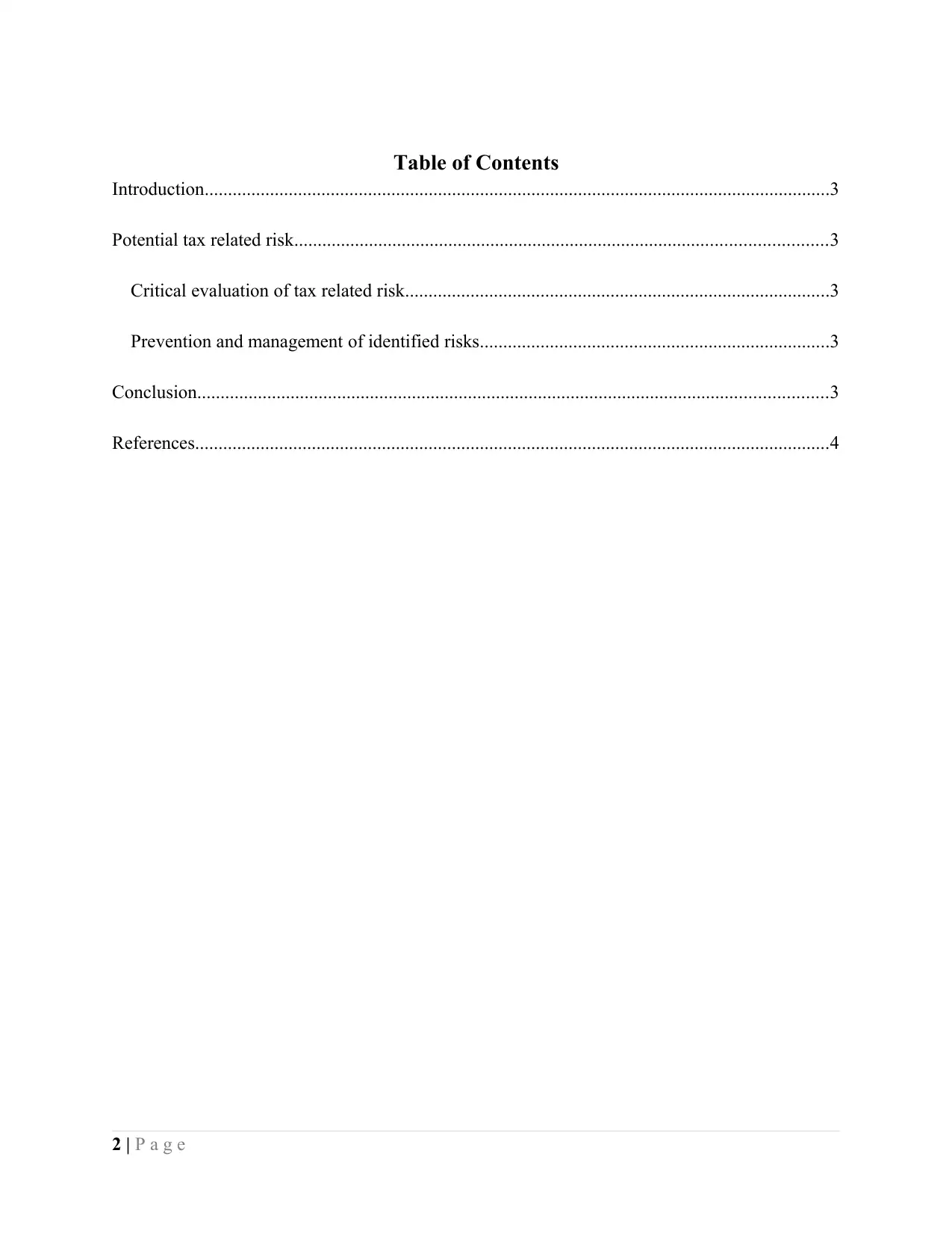
Table of Contents
Introduction......................................................................................................................................3
Potential tax related risk..................................................................................................................3
Critical evaluation of tax related risk...........................................................................................3
Prevention and management of identified risks...........................................................................3
Conclusion.......................................................................................................................................3
References........................................................................................................................................4
2 | P a g e
Introduction......................................................................................................................................3
Potential tax related risk..................................................................................................................3
Critical evaluation of tax related risk...........................................................................................3
Prevention and management of identified risks...........................................................................3
Conclusion.......................................................................................................................................3
References........................................................................................................................................4
2 | P a g e
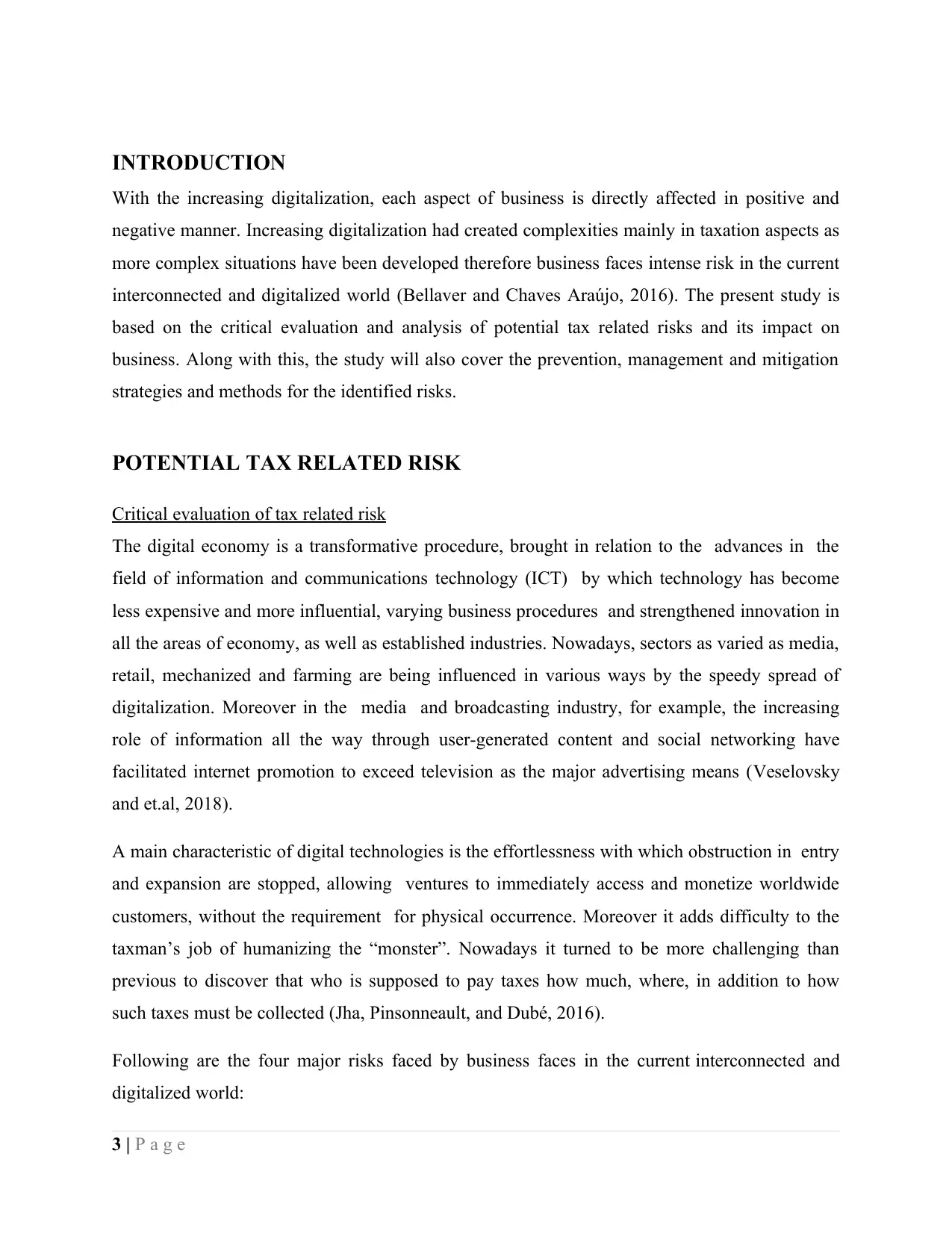
INTRODUCTION
With the increasing digitalization, each aspect of business is directly affected in positive and
negative manner. Increasing digitalization had created complexities mainly in taxation aspects as
more complex situations have been developed therefore business faces intense risk in the current
interconnected and digitalized world (Bellaver and Chaves Araújo, 2016). The present study is
based on the critical evaluation and analysis of potential tax related risks and its impact on
business. Along with this, the study will also cover the prevention, management and mitigation
strategies and methods for the identified risks.
POTENTIAL TAX RELATED RISK
Critical evaluation of tax related risk
The digital economy is a transformative procedure, brought in relation to the advances in the
field of information and communications technology (ICT) by which technology has become
less expensive and more influential, varying business procedures and strengthened innovation in
all the areas of economy, as well as established industries. Nowadays, sectors as varied as media,
retail, mechanized and farming are being influenced in various ways by the speedy spread of
digitalization. Moreover in the media and broadcasting industry, for example, the increasing
role of information all the way through user-generated content and social networking have
facilitated internet promotion to exceed television as the major advertising means (Veselovsky
and et.al, 2018).
A main characteristic of digital technologies is the effortlessness with which obstruction in entry
and expansion are stopped, allowing ventures to immediately access and monetize worldwide
customers, without the requirement for physical occurrence. Moreover it adds difficulty to the
taxman’s job of humanizing the “monster”. Nowadays it turned to be more challenging than
previous to discover that who is supposed to pay taxes how much, where, in addition to how
such taxes must be collected (Jha, Pinsonneault, and Dubé, 2016).
Following are the four major risks faced by business faces in the current interconnected and
digitalized world:
3 | P a g e
With the increasing digitalization, each aspect of business is directly affected in positive and
negative manner. Increasing digitalization had created complexities mainly in taxation aspects as
more complex situations have been developed therefore business faces intense risk in the current
interconnected and digitalized world (Bellaver and Chaves Araújo, 2016). The present study is
based on the critical evaluation and analysis of potential tax related risks and its impact on
business. Along with this, the study will also cover the prevention, management and mitigation
strategies and methods for the identified risks.
POTENTIAL TAX RELATED RISK
Critical evaluation of tax related risk
The digital economy is a transformative procedure, brought in relation to the advances in the
field of information and communications technology (ICT) by which technology has become
less expensive and more influential, varying business procedures and strengthened innovation in
all the areas of economy, as well as established industries. Nowadays, sectors as varied as media,
retail, mechanized and farming are being influenced in various ways by the speedy spread of
digitalization. Moreover in the media and broadcasting industry, for example, the increasing
role of information all the way through user-generated content and social networking have
facilitated internet promotion to exceed television as the major advertising means (Veselovsky
and et.al, 2018).
A main characteristic of digital technologies is the effortlessness with which obstruction in entry
and expansion are stopped, allowing ventures to immediately access and monetize worldwide
customers, without the requirement for physical occurrence. Moreover it adds difficulty to the
taxman’s job of humanizing the “monster”. Nowadays it turned to be more challenging than
previous to discover that who is supposed to pay taxes how much, where, in addition to how
such taxes must be collected (Jha, Pinsonneault, and Dubé, 2016).
Following are the four major risks faced by business faces in the current interconnected and
digitalized world:
3 | P a g e
⊘ This is a preview!⊘
Do you want full access?
Subscribe today to unlock all pages.

Trusted by 1+ million students worldwide
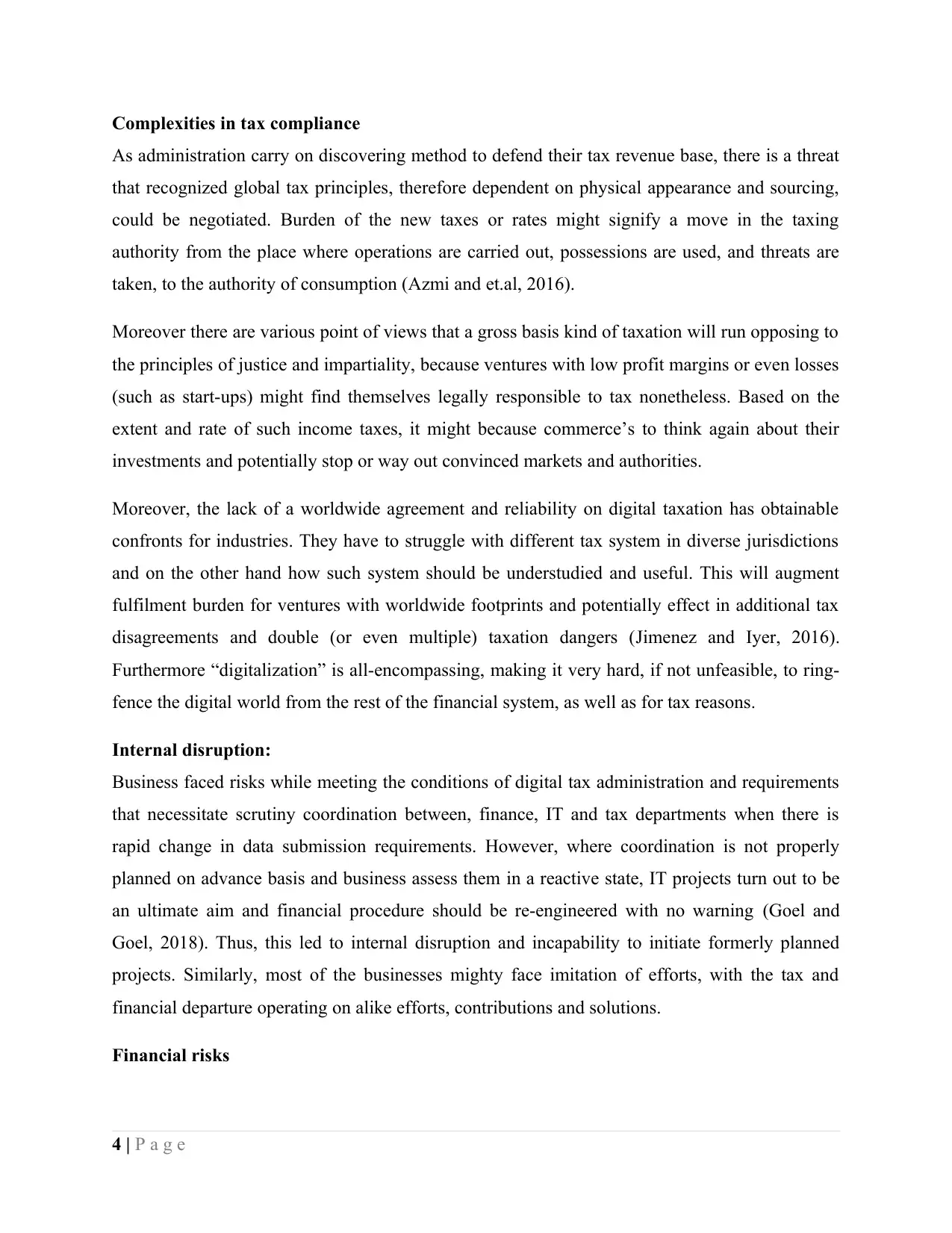
Complexities in tax compliance
As administration carry on discovering method to defend their tax revenue base, there is a threat
that recognized global tax principles, therefore dependent on physical appearance and sourcing,
could be negotiated. Burden of the new taxes or rates might signify a move in the taxing
authority from the place where operations are carried out, possessions are used, and threats are
taken, to the authority of consumption (Azmi and et.al, 2016).
Moreover there are various point of views that a gross basis kind of taxation will run opposing to
the principles of justice and impartiality, because ventures with low profit margins or even losses
(such as start-ups) might find themselves legally responsible to tax nonetheless. Based on the
extent and rate of such income taxes, it might because commerce’s to think again about their
investments and potentially stop or way out convinced markets and authorities.
Moreover, the lack of a worldwide agreement and reliability on digital taxation has obtainable
confronts for industries. They have to struggle with different tax system in diverse jurisdictions
and on the other hand how such system should be understudied and useful. This will augment
fulfilment burden for ventures with worldwide footprints and potentially effect in additional tax
disagreements and double (or even multiple) taxation dangers (Jimenez and Iyer, 2016).
Furthermore “digitalization” is all-encompassing, making it very hard, if not unfeasible, to ring-
fence the digital world from the rest of the financial system, as well as for tax reasons.
Internal disruption:
Business faced risks while meeting the conditions of digital tax administration and requirements
that necessitate scrutiny coordination between, finance, IT and tax departments when there is
rapid change in data submission requirements. However, where coordination is not properly
planned on advance basis and business assess them in a reactive state, IT projects turn out to be
an ultimate aim and financial procedure should be re-engineered with no warning (Goel and
Goel, 2018). Thus, this led to internal disruption and incapability to initiate formerly planned
projects. Similarly, most of the businesses mighty face imitation of efforts, with the tax and
financial departure operating on alike efforts, contributions and solutions.
Financial risks
4 | P a g e
As administration carry on discovering method to defend their tax revenue base, there is a threat
that recognized global tax principles, therefore dependent on physical appearance and sourcing,
could be negotiated. Burden of the new taxes or rates might signify a move in the taxing
authority from the place where operations are carried out, possessions are used, and threats are
taken, to the authority of consumption (Azmi and et.al, 2016).
Moreover there are various point of views that a gross basis kind of taxation will run opposing to
the principles of justice and impartiality, because ventures with low profit margins or even losses
(such as start-ups) might find themselves legally responsible to tax nonetheless. Based on the
extent and rate of such income taxes, it might because commerce’s to think again about their
investments and potentially stop or way out convinced markets and authorities.
Moreover, the lack of a worldwide agreement and reliability on digital taxation has obtainable
confronts for industries. They have to struggle with different tax system in diverse jurisdictions
and on the other hand how such system should be understudied and useful. This will augment
fulfilment burden for ventures with worldwide footprints and potentially effect in additional tax
disagreements and double (or even multiple) taxation dangers (Jimenez and Iyer, 2016).
Furthermore “digitalization” is all-encompassing, making it very hard, if not unfeasible, to ring-
fence the digital world from the rest of the financial system, as well as for tax reasons.
Internal disruption:
Business faced risks while meeting the conditions of digital tax administration and requirements
that necessitate scrutiny coordination between, finance, IT and tax departments when there is
rapid change in data submission requirements. However, where coordination is not properly
planned on advance basis and business assess them in a reactive state, IT projects turn out to be
an ultimate aim and financial procedure should be re-engineered with no warning (Goel and
Goel, 2018). Thus, this led to internal disruption and incapability to initiate formerly planned
projects. Similarly, most of the businesses mighty face imitation of efforts, with the tax and
financial departure operating on alike efforts, contributions and solutions.
Financial risks
4 | P a g e
Paraphrase This Document
Need a fresh take? Get an instant paraphrase of this document with our AI Paraphraser
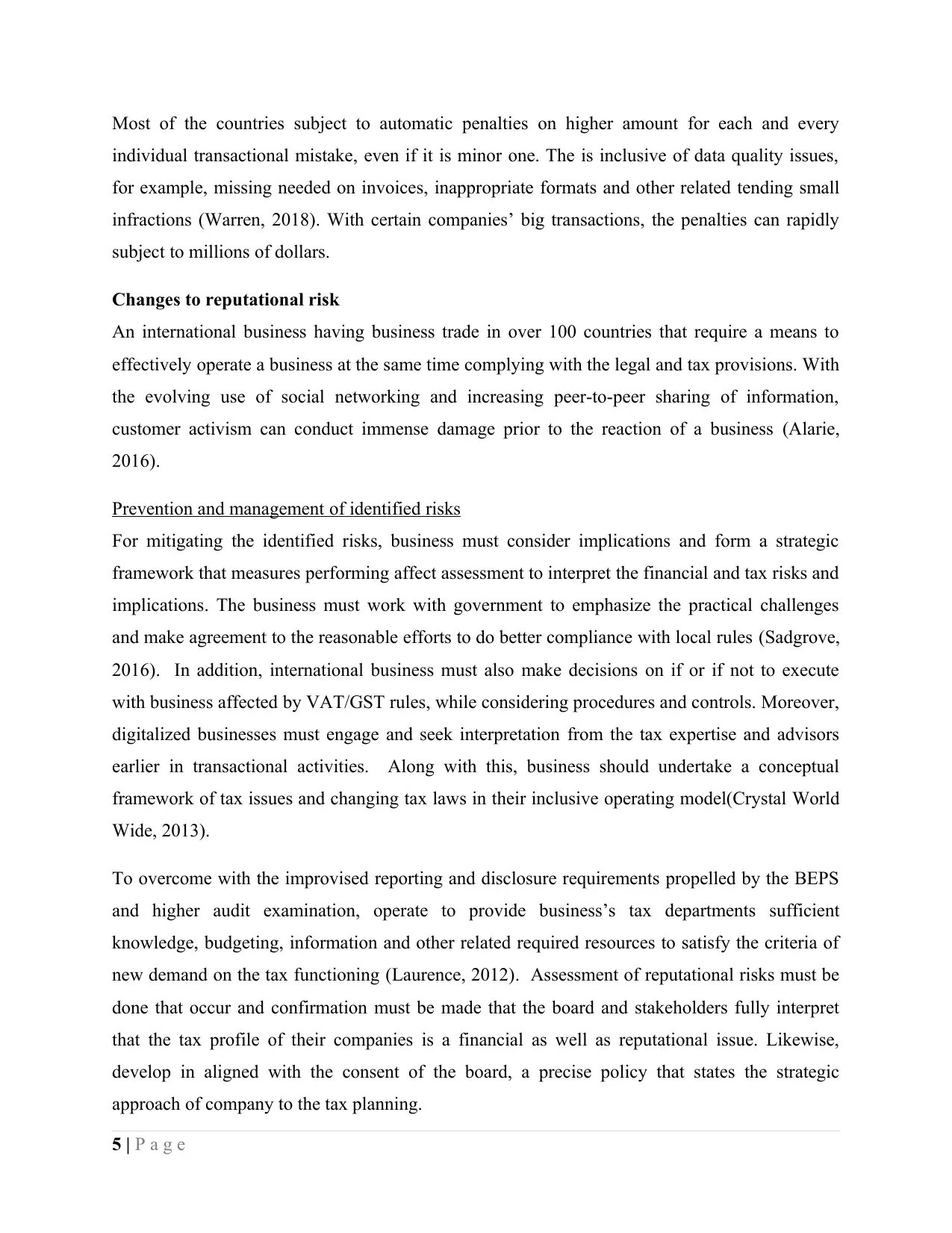
Most of the countries subject to automatic penalties on higher amount for each and every
individual transactional mistake, even if it is minor one. The is inclusive of data quality issues,
for example, missing needed on invoices, inappropriate formats and other related tending small
infractions (Warren, 2018). With certain companies’ big transactions, the penalties can rapidly
subject to millions of dollars.
Changes to reputational risk
An international business having business trade in over 100 countries that require a means to
effectively operate a business at the same time complying with the legal and tax provisions. With
the evolving use of social networking and increasing peer-to-peer sharing of information,
customer activism can conduct immense damage prior to the reaction of a business (Alarie,
2016).
Prevention and management of identified risks
For mitigating the identified risks, business must consider implications and form a strategic
framework that measures performing affect assessment to interpret the financial and tax risks and
implications. The business must work with government to emphasize the practical challenges
and make agreement to the reasonable efforts to do better compliance with local rules (Sadgrove,
2016). In addition, international business must also make decisions on if or if not to execute
with business affected by VAT/GST rules, while considering procedures and controls. Moreover,
digitalized businesses must engage and seek interpretation from the tax expertise and advisors
earlier in transactional activities. Along with this, business should undertake a conceptual
framework of tax issues and changing tax laws in their inclusive operating model(Crystal World
Wide, 2013).
To overcome with the improvised reporting and disclosure requirements propelled by the BEPS
and higher audit examination, operate to provide business’s tax departments sufficient
knowledge, budgeting, information and other related required resources to satisfy the criteria of
new demand on the tax functioning (Laurence, 2012). Assessment of reputational risks must be
done that occur and confirmation must be made that the board and stakeholders fully interpret
that the tax profile of their companies is a financial as well as reputational issue. Likewise,
develop in aligned with the consent of the board, a precise policy that states the strategic
approach of company to the tax planning.
5 | P a g e
individual transactional mistake, even if it is minor one. The is inclusive of data quality issues,
for example, missing needed on invoices, inappropriate formats and other related tending small
infractions (Warren, 2018). With certain companies’ big transactions, the penalties can rapidly
subject to millions of dollars.
Changes to reputational risk
An international business having business trade in over 100 countries that require a means to
effectively operate a business at the same time complying with the legal and tax provisions. With
the evolving use of social networking and increasing peer-to-peer sharing of information,
customer activism can conduct immense damage prior to the reaction of a business (Alarie,
2016).
Prevention and management of identified risks
For mitigating the identified risks, business must consider implications and form a strategic
framework that measures performing affect assessment to interpret the financial and tax risks and
implications. The business must work with government to emphasize the practical challenges
and make agreement to the reasonable efforts to do better compliance with local rules (Sadgrove,
2016). In addition, international business must also make decisions on if or if not to execute
with business affected by VAT/GST rules, while considering procedures and controls. Moreover,
digitalized businesses must engage and seek interpretation from the tax expertise and advisors
earlier in transactional activities. Along with this, business should undertake a conceptual
framework of tax issues and changing tax laws in their inclusive operating model(Crystal World
Wide, 2013).
To overcome with the improvised reporting and disclosure requirements propelled by the BEPS
and higher audit examination, operate to provide business’s tax departments sufficient
knowledge, budgeting, information and other related required resources to satisfy the criteria of
new demand on the tax functioning (Laurence, 2012). Assessment of reputational risks must be
done that occur and confirmation must be made that the board and stakeholders fully interpret
that the tax profile of their companies is a financial as well as reputational issue. Likewise,
develop in aligned with the consent of the board, a precise policy that states the strategic
approach of company to the tax planning.
5 | P a g e
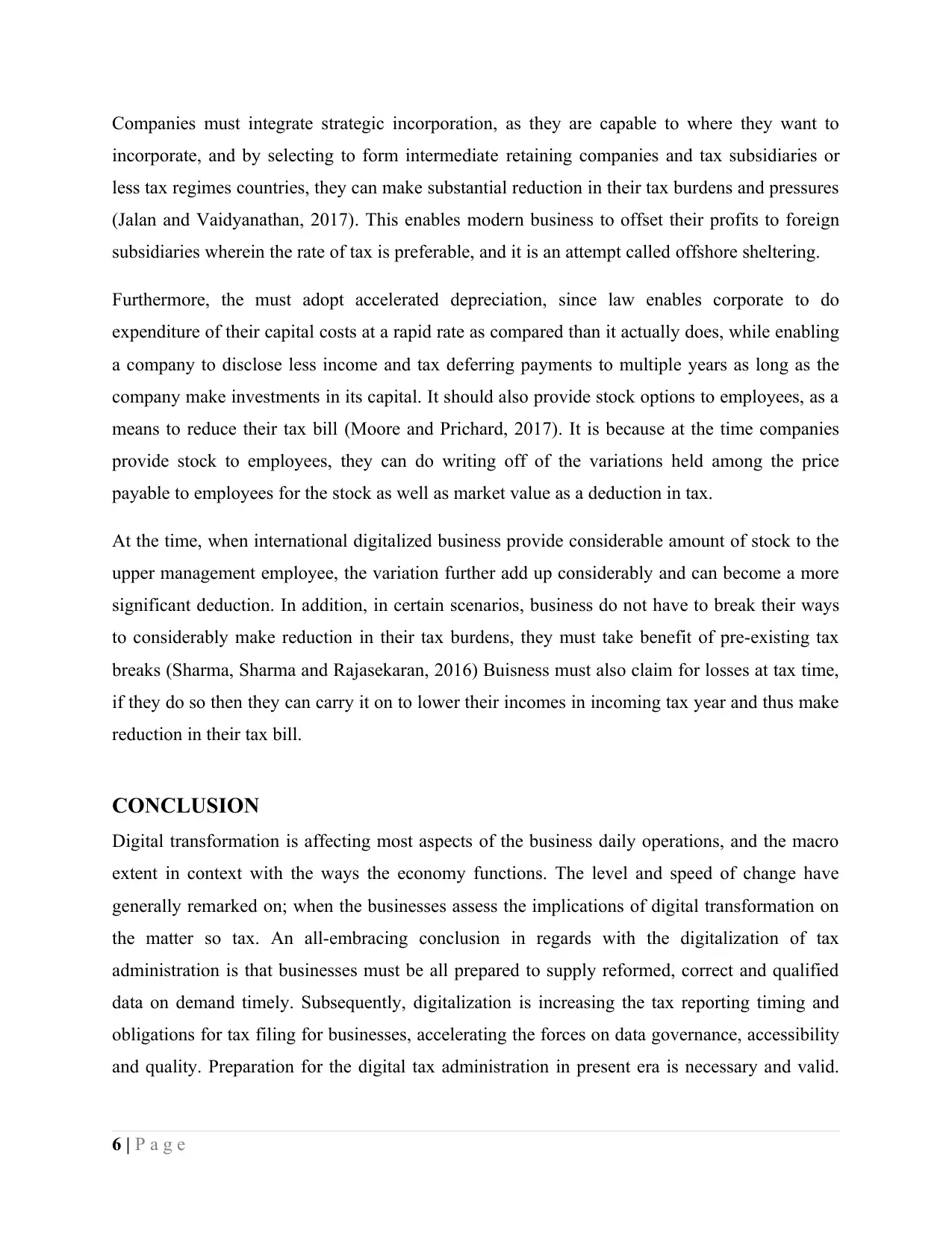
Companies must integrate strategic incorporation, as they are capable to where they want to
incorporate, and by selecting to form intermediate retaining companies and tax subsidiaries or
less tax regimes countries, they can make substantial reduction in their tax burdens and pressures
(Jalan and Vaidyanathan, 2017). This enables modern business to offset their profits to foreign
subsidiaries wherein the rate of tax is preferable, and it is an attempt called offshore sheltering.
Furthermore, the must adopt accelerated depreciation, since law enables corporate to do
expenditure of their capital costs at a rapid rate as compared than it actually does, while enabling
a company to disclose less income and tax deferring payments to multiple years as long as the
company make investments in its capital. It should also provide stock options to employees, as a
means to reduce their tax bill (Moore and Prichard, 2017). It is because at the time companies
provide stock to employees, they can do writing off of the variations held among the price
payable to employees for the stock as well as market value as a deduction in tax.
At the time, when international digitalized business provide considerable amount of stock to the
upper management employee, the variation further add up considerably and can become a more
significant deduction. In addition, in certain scenarios, business do not have to break their ways
to considerably make reduction in their tax burdens, they must take benefit of pre-existing tax
breaks (Sharma, Sharma and Rajasekaran, 2016) Buisness must also claim for losses at tax time,
if they do so then they can carry it on to lower their incomes in incoming tax year and thus make
reduction in their tax bill.
CONCLUSION
Digital transformation is affecting most aspects of the business daily operations, and the macro
extent in context with the ways the economy functions. The level and speed of change have
generally remarked on; when the businesses assess the implications of digital transformation on
the matter so tax. An all-embracing conclusion in regards with the digitalization of tax
administration is that businesses must be all prepared to supply reformed, correct and qualified
data on demand timely. Subsequently, digitalization is increasing the tax reporting timing and
obligations for tax filing for businesses, accelerating the forces on data governance, accessibility
and quality. Preparation for the digital tax administration in present era is necessary and valid.
6 | P a g e
incorporate, and by selecting to form intermediate retaining companies and tax subsidiaries or
less tax regimes countries, they can make substantial reduction in their tax burdens and pressures
(Jalan and Vaidyanathan, 2017). This enables modern business to offset their profits to foreign
subsidiaries wherein the rate of tax is preferable, and it is an attempt called offshore sheltering.
Furthermore, the must adopt accelerated depreciation, since law enables corporate to do
expenditure of their capital costs at a rapid rate as compared than it actually does, while enabling
a company to disclose less income and tax deferring payments to multiple years as long as the
company make investments in its capital. It should also provide stock options to employees, as a
means to reduce their tax bill (Moore and Prichard, 2017). It is because at the time companies
provide stock to employees, they can do writing off of the variations held among the price
payable to employees for the stock as well as market value as a deduction in tax.
At the time, when international digitalized business provide considerable amount of stock to the
upper management employee, the variation further add up considerably and can become a more
significant deduction. In addition, in certain scenarios, business do not have to break their ways
to considerably make reduction in their tax burdens, they must take benefit of pre-existing tax
breaks (Sharma, Sharma and Rajasekaran, 2016) Buisness must also claim for losses at tax time,
if they do so then they can carry it on to lower their incomes in incoming tax year and thus make
reduction in their tax bill.
CONCLUSION
Digital transformation is affecting most aspects of the business daily operations, and the macro
extent in context with the ways the economy functions. The level and speed of change have
generally remarked on; when the businesses assess the implications of digital transformation on
the matter so tax. An all-embracing conclusion in regards with the digitalization of tax
administration is that businesses must be all prepared to supply reformed, correct and qualified
data on demand timely. Subsequently, digitalization is increasing the tax reporting timing and
obligations for tax filing for businesses, accelerating the forces on data governance, accessibility
and quality. Preparation for the digital tax administration in present era is necessary and valid.
6 | P a g e
⊘ This is a preview!⊘
Do you want full access?
Subscribe today to unlock all pages.

Trusted by 1+ million students worldwide
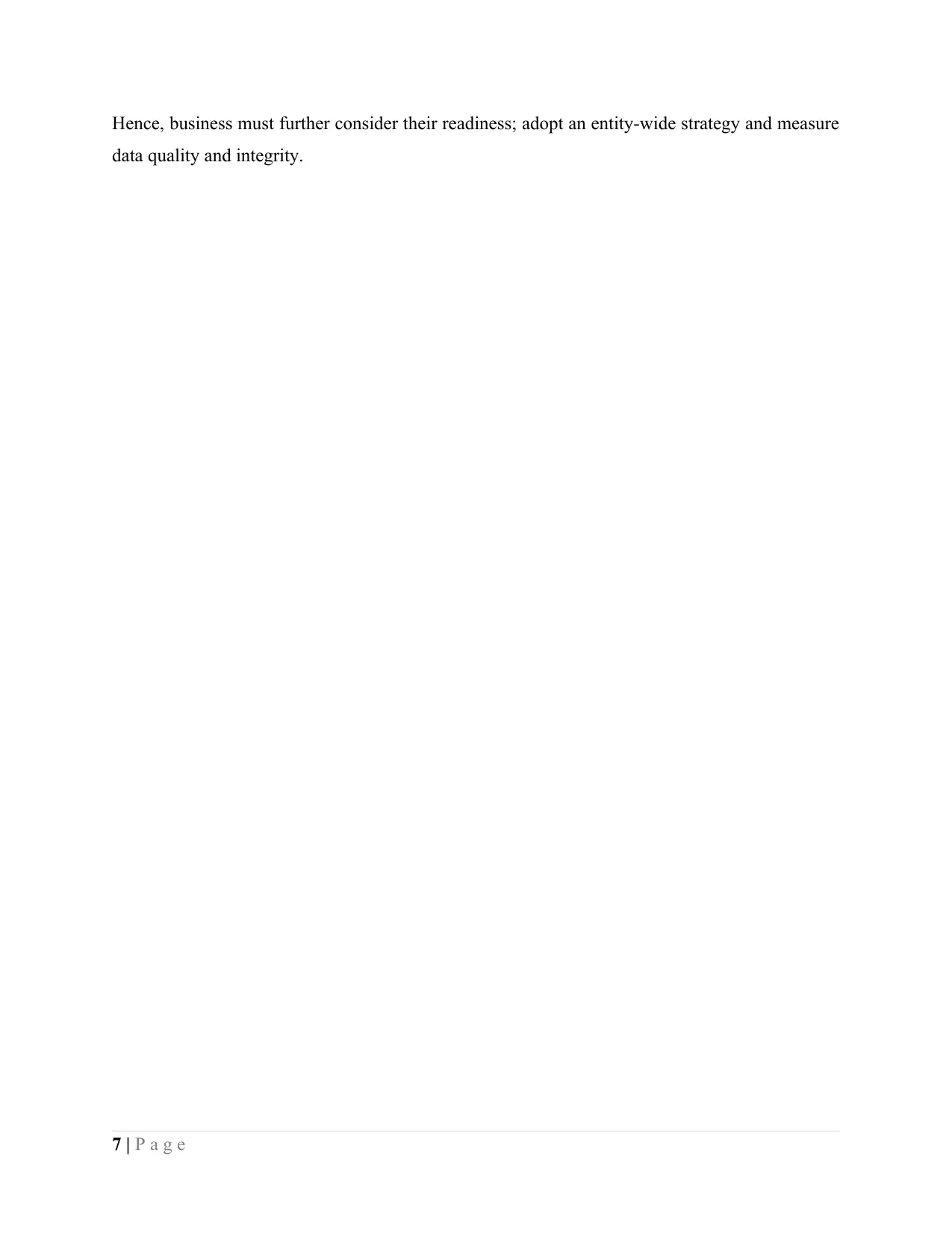
Hence, business must further consider their readiness; adopt an entity-wide strategy and measure
data quality and integrity.
7 | P a g e
data quality and integrity.
7 | P a g e
Paraphrase This Document
Need a fresh take? Get an instant paraphrase of this document with our AI Paraphraser

REFERENCES
Books and Journals
Alarie, B., 2016. The path of the law: Towards legal singularity. University of Toronto Law
Journal, 66(4), pp.443-455.
Azmi, A.A.C., Zainuddin, S., Mustapha, M.Z. and Nawi, Y., 2016. The Mediating Effect of Tax
Fairness on the Relationship Between Knowledge, Complexity and Voluntary Tax
Compliance. Asian Journal of Accounting Perspectives, pp.1-12.
Bellaver, R. and Chaves Araújo, P.H., 2016. Ethical Dimensions of International Tax Planning.
Goel, A. and Goel, S., 2018. Has the Permanent Establishment Rule Outlived Its Utility in a
Digitalized World. NUJS L. Rev., 11, p.25.
Jalan, A. and Vaidyanathan, R., 2017. Tax havens: conduits for corporate tax
malfeasance. Journal of Financial Regulation and Compliance, 25(1), pp.86-104.
Jha, S.K., Pinsonneault, A. and Dubé, L., 2016. The evolution of an ICT platform-enabled
ecosystem for poverty alleviation: The case of eKutir. MIS Quarterly, 40(2), pp.431-445.
Jimenez, P. and Iyer, G.S., 2016. Tax compliance in a social setting: The influence of social
norms, trust in government, and perceived fairness on taxpayer compliance. Advances in
accounting, 34, pp.17-26.
Moore, M. and Prichard, W., 2017. How Can Governments of Low-Income Countries Collect
More Tax Revenue?.
Sadgrove, K., 2016. The complete guide to business risk management. Routledge.
Sharma, V., Sharma, V. and Rajasekaran, K.S., 2016. Web-based and traditional outsourcing.
Auerbach Publications.
8 | P a g e
Books and Journals
Alarie, B., 2016. The path of the law: Towards legal singularity. University of Toronto Law
Journal, 66(4), pp.443-455.
Azmi, A.A.C., Zainuddin, S., Mustapha, M.Z. and Nawi, Y., 2016. The Mediating Effect of Tax
Fairness on the Relationship Between Knowledge, Complexity and Voluntary Tax
Compliance. Asian Journal of Accounting Perspectives, pp.1-12.
Bellaver, R. and Chaves Araújo, P.H., 2016. Ethical Dimensions of International Tax Planning.
Goel, A. and Goel, S., 2018. Has the Permanent Establishment Rule Outlived Its Utility in a
Digitalized World. NUJS L. Rev., 11, p.25.
Jalan, A. and Vaidyanathan, R., 2017. Tax havens: conduits for corporate tax
malfeasance. Journal of Financial Regulation and Compliance, 25(1), pp.86-104.
Jha, S.K., Pinsonneault, A. and Dubé, L., 2016. The evolution of an ICT platform-enabled
ecosystem for poverty alleviation: The case of eKutir. MIS Quarterly, 40(2), pp.431-445.
Jimenez, P. and Iyer, G.S., 2016. Tax compliance in a social setting: The influence of social
norms, trust in government, and perceived fairness on taxpayer compliance. Advances in
accounting, 34, pp.17-26.
Moore, M. and Prichard, W., 2017. How Can Governments of Low-Income Countries Collect
More Tax Revenue?.
Sadgrove, K., 2016. The complete guide to business risk management. Routledge.
Sharma, V., Sharma, V. and Rajasekaran, K.S., 2016. Web-based and traditional outsourcing.
Auerbach Publications.
8 | P a g e
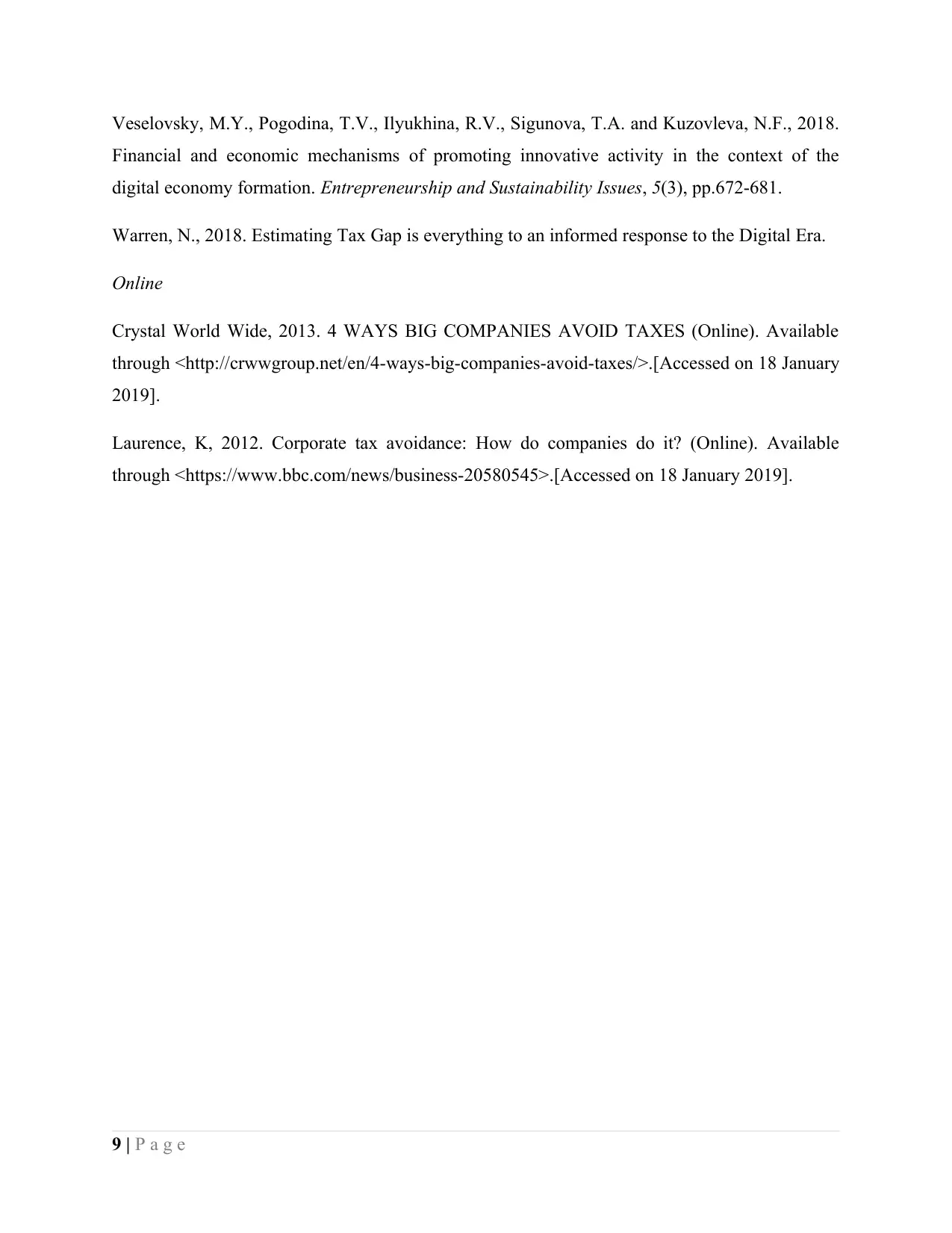
Veselovsky, M.Y., Pogodina, T.V., Ilyukhina, R.V., Sigunova, T.A. and Kuzovleva, N.F., 2018.
Financial and economic mechanisms of promoting innovative activity in the context of the
digital economy formation. Entrepreneurship and Sustainability Issues, 5(3), pp.672-681.
Warren, N., 2018. Estimating Tax Gap is everything to an informed response to the Digital Era.
Online
Crystal World Wide, 2013. 4 WAYS BIG COMPANIES AVOID TAXES (Online). Available
through <http://crwwgroup.net/en/4-ways-big-companies-avoid-taxes/>.[Accessed on 18 January
2019].
Laurence, K, 2012. Corporate tax avoidance: How do companies do it? (Online). Available
through <https://www.bbc.com/news/business-20580545>.[Accessed on 18 January 2019].
9 | P a g e
Financial and economic mechanisms of promoting innovative activity in the context of the
digital economy formation. Entrepreneurship and Sustainability Issues, 5(3), pp.672-681.
Warren, N., 2018. Estimating Tax Gap is everything to an informed response to the Digital Era.
Online
Crystal World Wide, 2013. 4 WAYS BIG COMPANIES AVOID TAXES (Online). Available
through <http://crwwgroup.net/en/4-ways-big-companies-avoid-taxes/>.[Accessed on 18 January
2019].
Laurence, K, 2012. Corporate tax avoidance: How do companies do it? (Online). Available
through <https://www.bbc.com/news/business-20580545>.[Accessed on 18 January 2019].
9 | P a g e
⊘ This is a preview!⊘
Do you want full access?
Subscribe today to unlock all pages.

Trusted by 1+ million students worldwide
1 out of 9
Your All-in-One AI-Powered Toolkit for Academic Success.
+13062052269
info@desklib.com
Available 24*7 on WhatsApp / Email
![[object Object]](/_next/static/media/star-bottom.7253800d.svg)
Unlock your academic potential
Copyright © 2020–2025 A2Z Services. All Rights Reserved. Developed and managed by ZUCOL.

